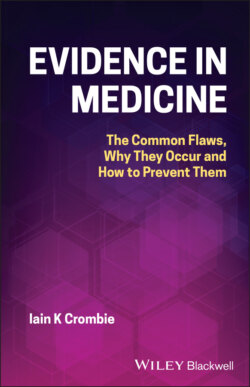Читать книгу Evidence in Medicine - Iain K. Crombie - Страница 25
Blinding of Outcome Assessment
ОглавлениеA long‐standing feature of trials is that the patient, and the person who measures patient status (the outcome) at the end of the trial, should be unaware of (blinded to) the treatment the participants received. This ensures that knowledge of treatment group does not influence the way the outcome is measured.
In many trials the method of blinding outcome assessment is poor. An evaluation of 20,920 trials included in Cochrane systematic reviews found that 31% of trials had unclear risk of blinding of participants and a further 33% were at high risk of bias [5]. For outcome assessment, 25% were at unclear risk of and 23% were at high risk of bias [5].
Another concern is whether blinding is compromised. This can happen when an intervention is sufficiently different from the control (e.g. by taste) that the patient identifies which treatment they have been given, and reveals this to the outcome assessor [30]. Few studies report whether they have assessed the risk that unblinding has occurred [31]. However one study that contacted the authors of published trials found that 43% has assessed this risk without reporting it, and that in 11% of studies it was likely that blinding had been compromised [30].
The impact of poor quality blinding on estimates of treatment effect is unclear, as review studies give conflicting results. Two overview studies found that poor blinding was associated with an increased effect size compared to well‐blinded trials [7, 32]. Another study found that this bias only occurred for subjective outcome measures [2], and a fourth reported an inconsistent effect [18]. The most recent, and largest, study concluded that there was no effect of blinding [33].
